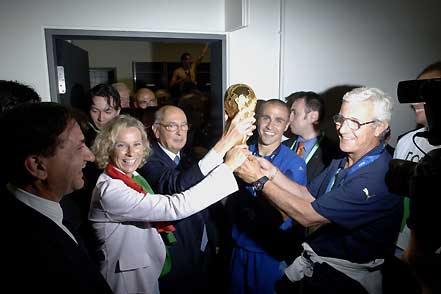The United States have football, baseball, basketball. Italy has soccer.
Not merely a game, but a symbol of our country worldwide, despite the natural ups and downs in major competitions. In Italy, soccer is one of the most common subjects of conversation, making people either fight or come together. Supporting a team is something very serious – as confirmed by the recent turmoil in Rome. But on some occasions, fans of different clubs and Italians living in different countries finally join their passionate voices — when a goal is scored by the Azzurri – the Italian national team.
This summer the Azzurri of soccer will face a new challenge: the 20thWorld Cup to be played in Brazil. The long-awaited event will be accompanied by the exhibition “La Nazionale tra emozioni e storia. Un secolo di calcio azzurro” (The National team: emotions and history of a century of Italian soccer), which runs from May 6 through July 27 at Rome’s Auditorium, not far from the Olympic Stadium.
Promoted by the FIGC (Italian Soccer Federation) and the technical sponsor Puma in collaboration with the City of Rome, Fondazione Museo del Calcio, and Fondazione Musica per Roma, the exhibit is meant to celebrate the 104th anniversary of the Azzurri team, and was presented by President of the Italian Republic Giorgio Napolitano. Over a century of success will be showcased through trophies, balls, shirts, documents, videos, and pictures – including those of all the 760 players who have worn the azure shirt so far -, closely tied to Italy’s social, political, and cultural history.
The Italian national team debuted on May 15, 1910 defeating France, and today it is among the best in the world, boasting 4 World Cups (in 1934, 1938, 1982, 2006) as well as many other titles at an international and European level.
The nickname Azzurri refers to the color of the shirt, which was changed from white to azure in 1911 on the occasion of the team’s third official match, this time against Hungary. Azure or blue was the color of the Kingdom of Italy, in fact it was known as “Savoy blue” in honor of the royal dynasty that unified the country in 1861. Since then, the color azure has represented Italian national teams and athletes in all major sports. After World War II, when Italy became a Republic, the Italian tricolor shield replaced the royal standard embroidered on the shirt.
Among the most striking memorabilia on view – some of them never seen before, and coming from different soccer-themed museums across Italy – are Silvio Piola’s shirt that was hand-embroidered by his mother; soccer player and manager Enzo Bearzot’s pipes; the black shirt imposed by Benito Mussolini in 1938; a model of the Olympic Stadium from the 1990 World Cup; and of course the replica of the cult 2006 World Cup in a special display case. For those who didn’t know, the prestigious Cup was designed by Italian artist Silvio Gazzaniga in the early 1970s, and the original remains in FIFA’s own possession in order to prevent it from being stolen again, as happened in 1966 and 1983.
Thanks to modern technologies and interactive devices such as touchscreen monitors, but also to the availability of original audio recordings, the public will be offered the opportunity to experience again or for the first time the unique emotions that this sport can arouse.





























